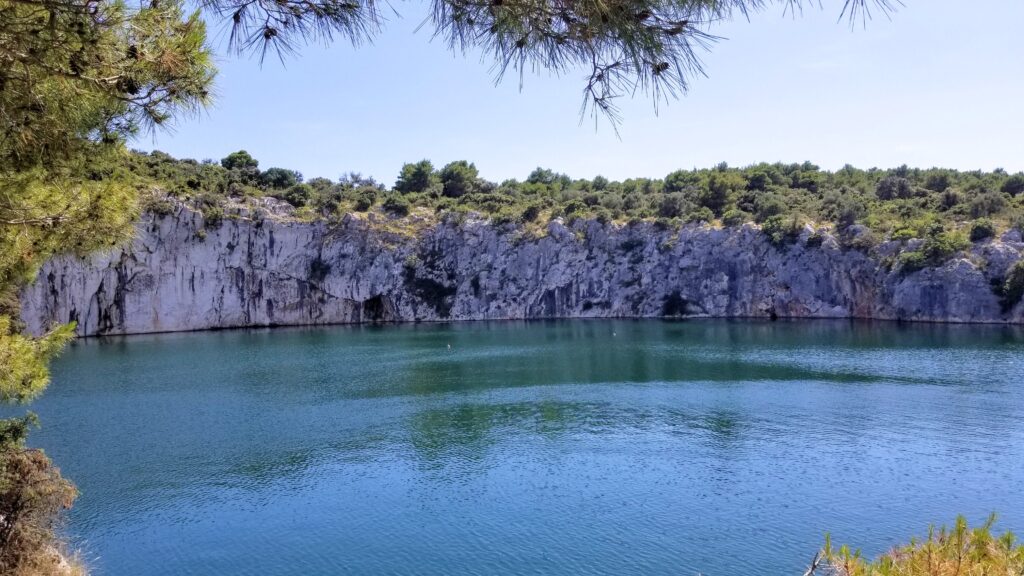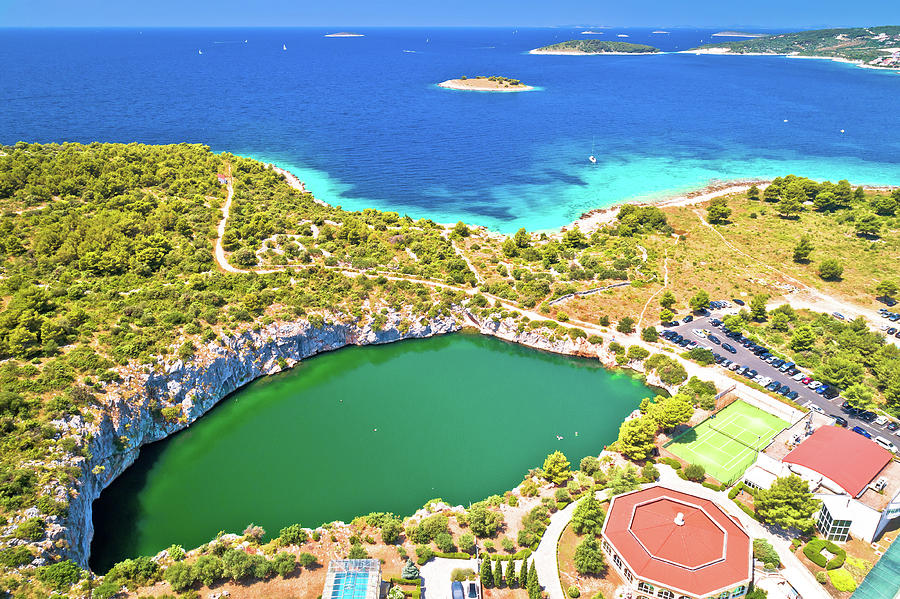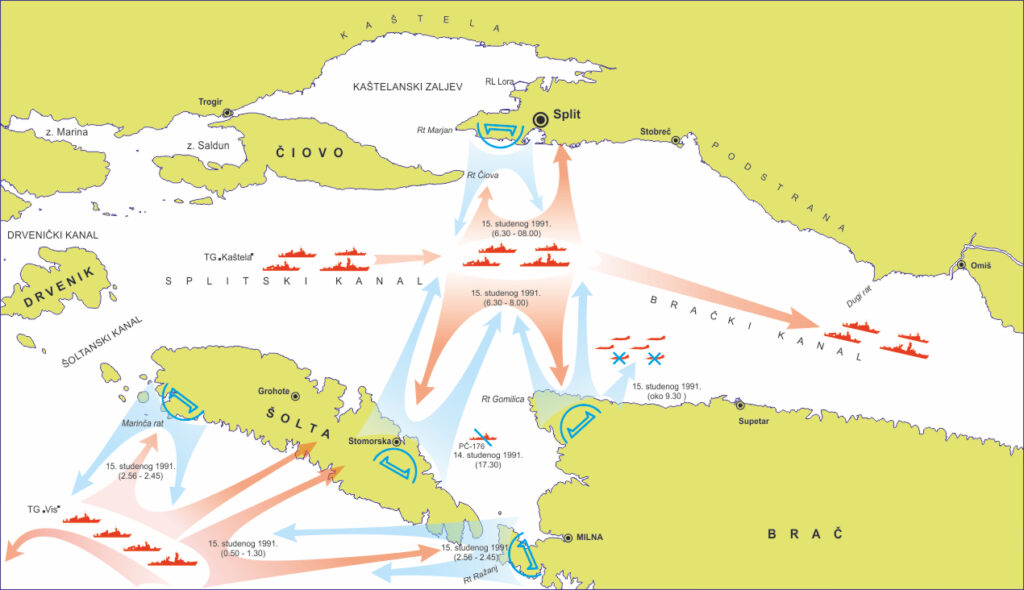drago (I)
dragón (S)
drachen/drache/lindwurm (G)
dragão (P)
dragon (E)
dragon’s eye, rogoznica, croatia


The Dragon’s Eye is a 10,000 square meter lake near Rogoznica, Dalmatia, Croatia. As you can see from the picture, it’s very close to the Adriatic Ocean, connected to it through channels and cracks in the limestone, so its waters are salty. It’s deep-up to 15 meters and is surrounded by cliffs that are as high as 24 meters. The water is warmer the deeper you dive as it has hydrogen sulphide in it.
The name “Dragon’s Eye” accompanies a legend regarding the lake. Supposedly, a dragon named Murin protected Heraclea, a name given to a number of places in the Mediterranean, including nearby Hvar Island. In exchange for protection, the dragon demanded, not just once, but every year on the longest day of the year, the most beautiful girl on the island as his wife. Unfortunately, these girls wouldn’t survive their wedding nights. Aristoles arrived on the winged horse Pegasus one year and fell in love with the “lucky” bride to be that year. He challenged the dragon to a duel and impaled him with a spear made by the goddess Athena. Murin, knowing he was dying, gouged out his eyes, one of which melted the rock and made the depression which became the lake. Another legend holds that if two people in love bathe in the Dragon’s Eye, they will have eternal love and happiness.
The Dragon’s Eye is bordered by Marina Frapa, one of dozens of beautiful and luxurious marinas along the coast of Croatia. You may not know it but Croatia is one of the best places in the world to boat, more specifically, to sail. There are hundreds of anchorages, marinas and towns to explore. You may have seen some of them on Bravo’s Below Deck Sailing Yacht, Season 2, starring Parsifal III, the super sailing yacht. For those with good sailing skills and, perhaps, a more limited budget, Croatia is home to hundreds of sailboats available for bareboat charter during the season on a weekly basis. (You will have to make your own breakfast and mix your own drinks.) Every Saturday and Sunday, a fleet/armada of yachts set sail from marinas along the Croatian coast, heading to destinations on the islands offshore such as Brač, Korčula, Hvar, Vis, Šolta, or the Kornati Islands National Park.
When you think of naval battles, it might conjure up times past, maybe battles in the Pacific during World War II or battles between Spain and England in Elizabethan times. Yet, less than 45 years ago, the waters now crawling with sailboats were the location of the Battle of the Dalmatian Channels, a three-day battle between the Yugoslav Navy and coastal artillery and a detachment of naval commandoes of the Croatian Navy. The battle occurred between November 14 and 16th, 1991. Croatia had declared independence from Yugoslavia on June 25, 1991. There had been various skirmishes, battles and massacres that year. A blockade of the Croatian coast had been imposed by the Yugoslav navy.

On November 14, 1991, Croatian commandoes torpedoed a Yugoslavian patrol boat, the Mukos, near the island of Brač in the Split channel. In retaliation, the Yugoslav navy bombarded Brač and the island of Šolta. The Mukos was salvaged by Croatian boats and beached on Šolta. On November 15, 1991, a group of Yugoslav Navy vessels bombarded the city of Split in retaliation for the loss of the Mukos. Croatian coastal artillery engaged the vessels as well as other vessels deployed from the island of Vis, an outermost island, including three minesweepers. On November 16, 1991, the Yugoslav ships sailed through the Korčula Channel, between Hvar and Korčula, heading for Vis. Croatian coastal artillery took out two minesweepers. After the battle, the Yugoslavian coastal blockade was loosened. The Mukos was eventually towed past the Dragon’s Eye in Rogoznica to the city of Šibenik, repaired and commissioned into the Croatian navy as the OB-62 Šolta. During the battle, twenty-two Yugoslav Navy crewmen; two Croatian gunners; and two civilian sailors in Split were killed.
The war continued until 1995. In 1996, the former republic of Yugoslavia recognized Croatia, Bosnia and Herzegovina and Macedonia. Croatia has been a member of the European Union since 2013 and, on January 1, 2023, adopted the euro as its currency and became part of the Schengen area, which allows for free movement of citizens within those countries.
A postscript regarding the island of Vis: During World War II, it was the main base for partisans fighting the Germans. British Special forces were on Vis, assisting the partisans and a sea cave on a small island off Vis provided a hiding place for a British naval torpedo vessel. After the war ended, the Yugoslavian leader Josip Broz Tito, who had led the partisans during the war and was the leader of Yugoslavia until his death in 1980, turned Vis into a military base. Foreigners were not allowed to visit or sail within 300 meters of Vis until 1989. Today, Vis is more well known as a great offshore sailing destination and…as the 2017 filming location of the movie, Mama Mia, Here We Go Again (the one with lots of Lily James and Amanda Seyfreid; a bit of Cher and hardly any Meryl Streep). Yes, despite all the discussion of Greece and the signs using the Greek alphabet, Pierce Brosnan, Colin Firth, Stellan Skarsgård, Andy Garcia, Christine Baranski and Julie Walters were all filming on Vis.
I